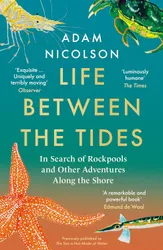This book is anchored in a particular place on the west coast of Scotland, near the Isle of Mull. But it ranges widely across time and subject matter, taking in nature, science, history and myth.
From a scientific perspective, the book focuses on a number of rock pools that the author constructs (with permission) on the shoreline, and the plants and animals that take up residence there. He observes their behaviours patiently and carefully and for many of these organisms we learn about their lifestyle and how they make a living in the area between high and low tide. One of the creatures we learn about is the green shore crab, the mating habits of which are particularly fascinating. The interplay between plants and animals and competition between different organisms is also discussed at length.
The author appears to have spent a considerable amount of time constructing and then peering into his artificial rock pools. One thing that isn’t really discussed is whether this area already contained rock pools he could have investigated instead. It’s also not discussed what effect these rock pools might have on the surrounding ecosystem. It’s a little unusual to read a book about nature that is so explicitly interventionist in this way. At one point, travelling further afield, the book discusses an oil spill off Cornwall in the 1960s and how this, and the use of dispersant chemicals, affected the ecosystem, which still hasn’t recovered to this day. Clearly we don’t live in a world that is uninfluenced by human habitation, and building a few rock pools is obviously not going to have the same effect as a massive oil spill. But something about the author’s willingness to tinker with the landscape simply in order to create a place for him to play with nature made me slightly uncomfortable. Still the author’s obvious love for the natural world and the detail and careful observations he makes are fascinating to read about.
The book is quite poetic and at certain points the narrative drifts away from nature towards some of the human history of the place, including speculation about the prehistoric human occupants. The book also tells of various myths and legends that are located nearby, many of which relate to the sort of ‘no place’ that exists between low and high tides; a place which is sometimes land and sometimes water. Returning to science we learn about a couple of scientists who had an impact on this place. One is Philip Henry Gosse, who spent his life trying to bring the evidence of billions of years of evolution into a religious framework. Another is Herbert Spencer, who during a brief stay may have coined the phrase ‘survival of the fittest’ to describe Darwin’s theory of evolution. Darwin himself included this phrase in later editions of On The Origin of Species.
One of the most interesting scientific tangents the book takes is in describing what causes the tides, and the story behind human attempts to understand them. Although I knew before (from school, or possibly university) what causes the high and low tides, I really enjoyed the explanations of the earlier, incorrect theories that were proposed at various times.
I enjoyed reading this book. It is something to read slowly; to savour the beautiful writing and to enjoy the sense of place this book evokes.
